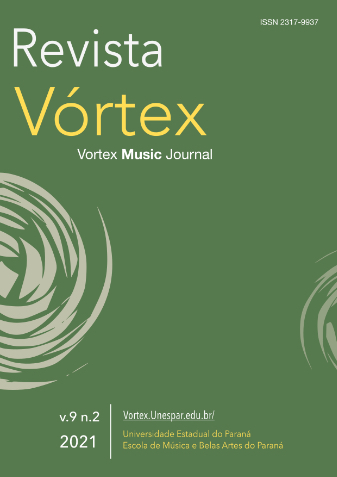Elastic Rhythm in Signal-Synchronised Sequencing Objects for Pure Data
DOI:
https://doi.org/10.33871/23179937.2021.9.2.24Palabras clave:
polyrhythm, polymeter, sequence, isorhythm, synchronisedResumen
This paper presents a family of objects for manipulating polyrhythmic sequences and isorhythmic relationships, in both the signal and event domains. These work together and are tightly synchronised to an audio phase signal, so that relative temporal relationships can be tempo-manipulated in a linear fashion. Many permutations of polyrhythmic sequences including incomplete tuplets, scrambled elements, interleaved tuplets and any complex franctional relation can be realised. Similarly, these many be driven with controllable isorhythmic generators derived from a single driver, so that sequences of different fractionally related lengths may be combined and synchronised. It is possible to use signals to drive audio playback that are directly generated, so that disparate sound files may be combined into sequences. A set of sequenced parameters are included to facilitate this process.Descargas
Citas
KELLY, Edward. Time in Music: Strategies for Engagement, PhD thesis, University of East Anglia, July 2005, pp88-98. http://sharktracks.co.uk/ed/epk_thesis.pdf
KRAMER, Jonathan D. The Time of Music, New Meanings, New Temporalities, New Listening Strategies. Macmillan,1988.
MANOURY, Phillipe. The Arrow of Time, Contemporary Music Review, 1:1 pp. 131-145. 1984
PUCKETTE, Miller. Pure Data, In: Proceedings of International Computer Music Conference, Ed. 20, San Francisco, 1996
READ, Gardner. Modern Rhythmic Notation, Bloomington: Indiana University Press, 1978, pp. 22 onwards.
STOCKHAUSEN, Karlheinz. ...How Time Passes"¦ In: Die Reihe, 3. Massachusetts: Theodore Presser co., English language version, translated by Cornelius Cardew, 1959
Descargas
Publicado
Cómo citar
Número
Sección
Licencia
Derechos de autor 2021 Edward Kelly

Esta obra está bajo una licencia internacional Creative Commons Atribución 4.0.
Los autores conservan los derechos de autor y conceden a la revista el derecho de primera publicación, con el trabajo simultáneamente bajo la licencia Creative Commons Attribution Licence que permite compartir el trabajo con reconocimiento de autoría y publicación inicial en esta revista.






